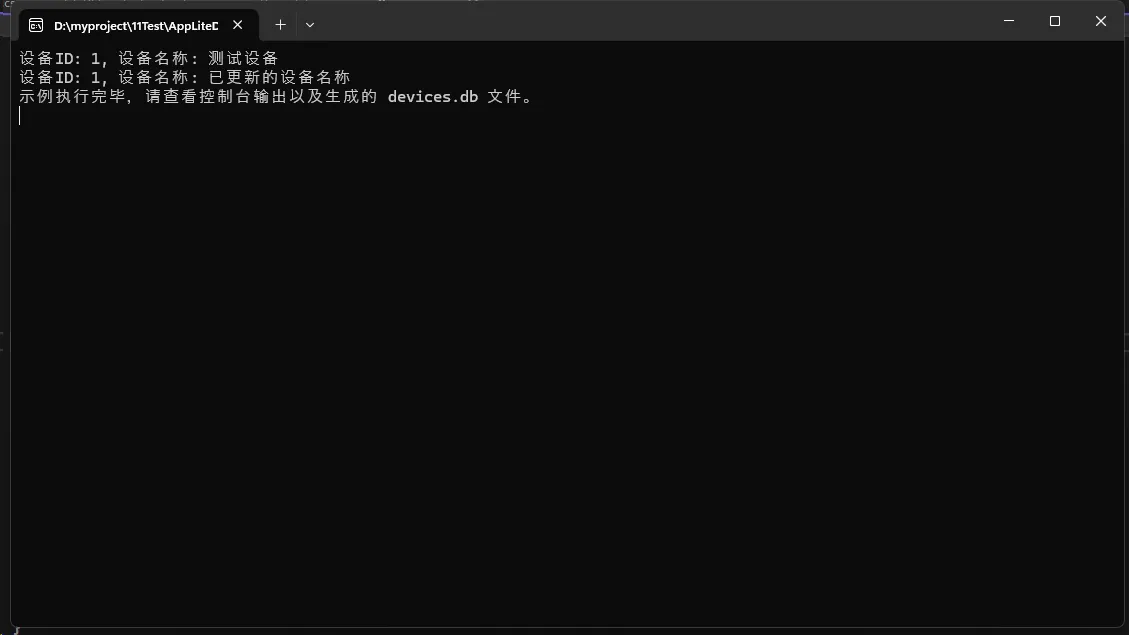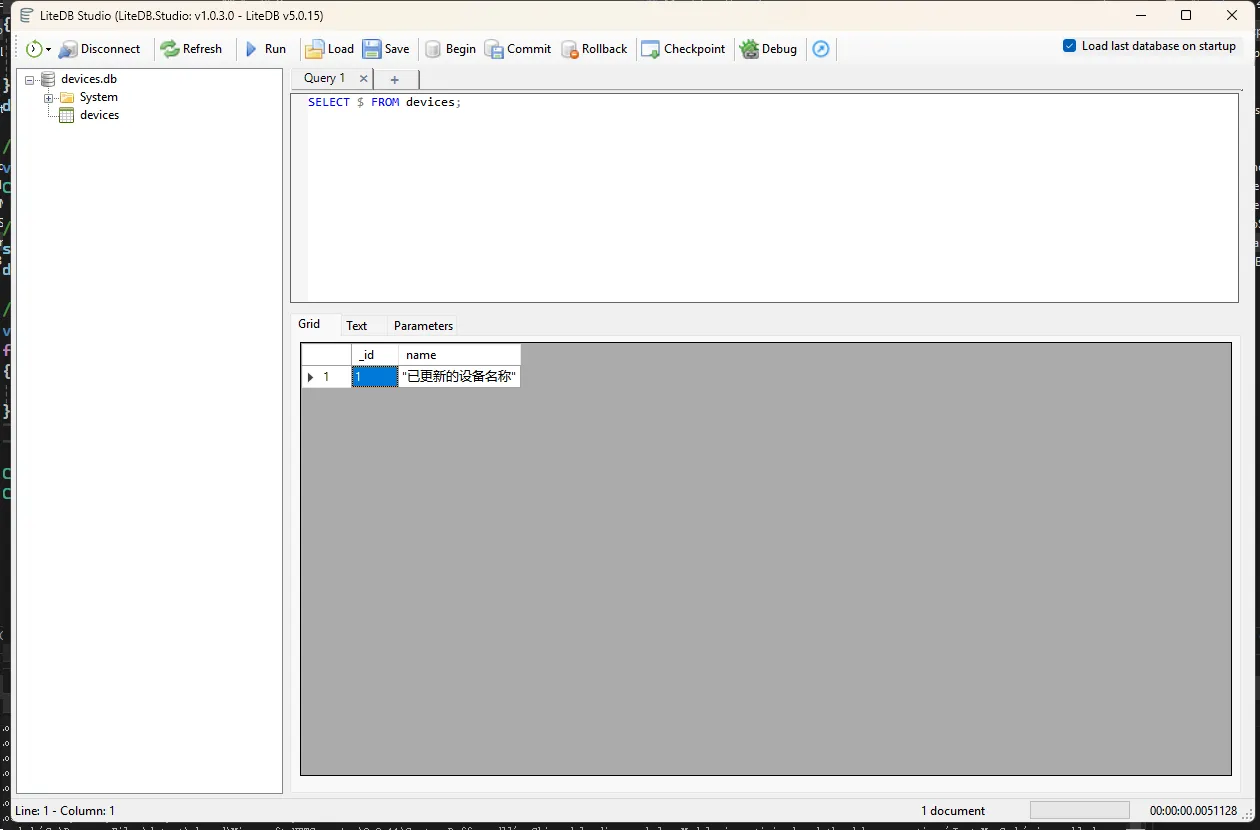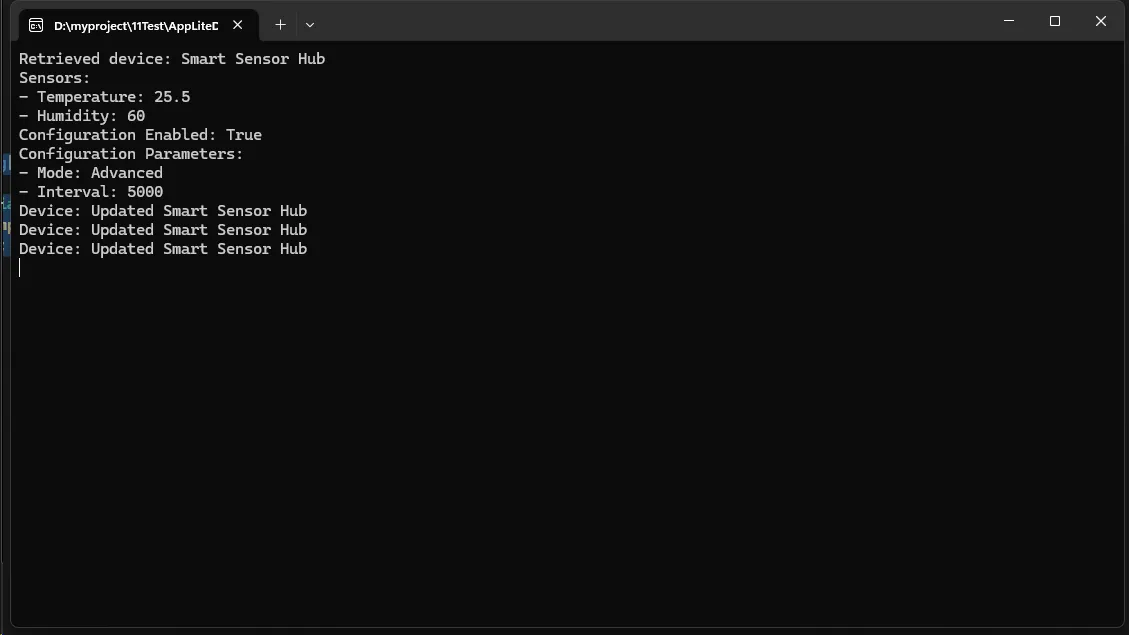目录
序列化概述
LiteDB 提供了强大且灵活的序列化机制,能够处理各种复杂的对象序列化场景。本文将深入探讨 LiteDB 的高级序列化特性和最佳实践。
Nuget 安装LiteDB包

基本序列化支持
LiteDB 默认支持多种 .NET 类型的序列化:
- 基本类型(int, string, bool 等)
- 复杂对象
- 集合类型(List, Dictionary)
- 枚举类型
- 可空类型(Nullable)
高级序列化配置
忽略特定属性
在某些场景下,您可能希望在序列化过程中排除某些属性。LiteDB 提供了 Ignore 方法来实现这一需求。
C#using System;
using System.Collections.Generic;
using System.Linq;
using System.Text;
using System.Threading.Tasks;
using LiteDB;
namespace App05
{
public class DeviceInfo
{
[BsonId] // 明确标记 Id 字段
public int Id { get; set; }
public string DeviceName { get; set; }
// 利用特性进行忽略
[BsonIgnore]
public object TemporaryData { get; set; }
}
}
C#using System;
using LiteDB;
namespace App05
{
internal class Program
{
static void Main(string[] args)
{
// 直接使用数据库,不需要额外配置
using (var db = new LiteDatabase("MyData.db"))
{
// 获取集合
var deviceCollection = db.GetCollection<DeviceInfo>("devices");
// 插入测试数据
var deviceInfo = new DeviceInfo
{
DeviceName = "Sample Device",
TemporaryData = new { Note = "Some temporary data" }
};
deviceCollection.Insert(deviceInfo);
Console.WriteLine("插入成功,Id = " + deviceInfo.Id);
// 查询所有数据
var allDevices = deviceCollection.FindAll();
foreach (var device in allDevices)
{
Console.WriteLine($"Id: {device.Id}, DeviceName: {device.DeviceName}");
}
// 更新数据示例
deviceInfo.DeviceName = "Updated Device Name";
deviceCollection.Update(deviceInfo);
// 查询单条记录
var singleDevice = deviceCollection.FindById(deviceInfo.Id);
Console.WriteLine($"更新后单条记录: Id = {singleDevice.Id}, DeviceName = {singleDevice.DeviceName}");
// 删除数据示例
deviceCollection.Delete(deviceInfo.Id);
Console.WriteLine("删除成功");
}
Console.WriteLine("示例执行完毕,请查看控制台输出以及生成的 MyData.db 文件。");
Console.ReadLine();
}
}
}

自定义字段映射
您可以自定义属性在 BSON 文档中的键名,这在处理遗留系统或需要特定命名约定时非常有用。
C#public class DeviceInfo
{
public int Id { get; set; }
public string DeviceName { get; set; }
}
public class LiteDbSerializationConfig
{
public static void ConfigureSerializer()
{
// 自定义字段映射
BsonMapper.Global.Entity<DeviceInfo>()
.Field(x => x.DeviceName, "name") // 将 DeviceName 映射为 "name"
.Field(x => x.Id, "_id"); // 将 Id 映射为 "_id"
}
}
C#using System;
using System.Collections.Generic;
using System.Linq;
using System.Text;
using System.Threading.Tasks;
using LiteDB;
namespace App05
{
// 设备管理类
public class DeviceManager
{
private readonly string _dbPath;
public DeviceManager(string dbPath)
{
_dbPath = dbPath;
}
// 添加设备
public void AddDevice(DeviceInfo device)
{
using (var db = new LiteDatabase(_dbPath))
{
var collection = db.GetCollection<DeviceInfo>("devices");
collection.Insert(device);
}
}
// 获取所有设备
public List<DeviceInfo> GetAllDevices()
{
using (var db = new LiteDatabase(_dbPath))
{
var collection = db.GetCollection<DeviceInfo>("devices");
return collection.FindAll().ToList();
}
}
// 根据ID获取设备
public DeviceInfo GetDeviceById(int id)
{
using (var db = new LiteDatabase(_dbPath))
{
var collection = db.GetCollection<DeviceInfo>("devices");
return collection.FindById(id);
}
}
// 更新设备信息
public bool UpdateDevice(DeviceInfo device)
{
using (var db = new LiteDatabase(_dbPath))
{
var collection = db.GetCollection<DeviceInfo>("devices");
return collection.Update(device);
}
}
// 删除设备
public bool DeleteDevice(int id)
{
using (var db = new LiteDatabase(_dbPath))
{
var collection = db.GetCollection<DeviceInfo>("devices");
return collection.Delete(id);
}
}
}
}
C#using System;
using LiteDB;
namespace App05
{
internal class Program
{
static void Main(string[] args)
{
// 配置序列化
LiteDbSerializationConfig.ConfigureSerializer();
// 创建设备管理器实例
var deviceManager = new DeviceManager("devices.db");
// 添加设备
var device = new DeviceInfo
{
Id = 1,
DeviceName = "测试设备"
};
deviceManager.AddDevice(device);
// 获取设备
var savedDevice = deviceManager.GetDeviceById(1);
Console.WriteLine($"设备ID: {savedDevice.Id}, 设备名称: {savedDevice.DeviceName}");
// 更新设备
savedDevice.DeviceName = "已更新的设备名称";
deviceManager.UpdateDevice(savedDevice);
// 获取所有设备
var allDevices = deviceManager.GetAllDevices();
foreach (var d in allDevices)
{
Console.WriteLine($"设备ID: {d.Id}, 设备名称: {d.DeviceName}");
}
Console.WriteLine("示例执行完毕,请查看控制台输出以及生成的 devices.db 文件。");
Console.ReadLine();
}
}
}


复杂对象序列化
对于包含嵌套对象和集合的复杂类型,LiteDB 提供了灵活的序列化机制。
C#using System;
using System.Collections.Generic;
using System.Linq;
using System.Text;
using System.Threading.Tasks;
namespace App05
{
// 定义复杂设备类
public class ComplexDevice
{
public int Id { get; set; }
public string Name { get; set; }
public List<Sensor> Sensors { get; set; }
public DeviceConfiguration Configuration { get; set; }
}
// 传感器类
public class Sensor
{
public string Type { get; set; }
public double Value { get; set; }
}
// 设备配置类
public class DeviceConfiguration
{
public bool IsEnabled { get; set; }
public Dictionary<string, string> Parameters { get; set; }
}
}
C#using System;
using System.Collections.Generic;
using System.Linq;
using System.Text;
using System.Threading.Tasks;
using LiteDB;
namespace App05
{
public class SerializationDemo
{
public void DemonstrateComplexSerialization()
{
try
{
// 配置序列化映射
var mapper = new BsonMapper();
// 创建示例设备对象
var device = new ComplexDevice
{
Name = "Smart Sensor Hub",
Sensors = new List<Sensor>
{
new Sensor { Type = "Temperature", Value = 25.5 },
new Sensor { Type = "Humidity", Value = 60.0 }
},
Configuration = new DeviceConfiguration
{
IsEnabled = true,
Parameters = new Dictionary<string, string>
{
{ "Mode", "Advanced" },
{ "Interval", "5000" }
}
}
};
// 使用配置的mapper创建数据库连接
using (var db = new LiteDatabase(@"MyDatabase.db", mapper))
{
// 获取集合
var collection = db.GetCollection<ComplexDevice>("devices");
// 创建索引
collection.EnsureIndex(x => x.Name);
// 插入数据
collection.Insert(device);
// 读取示例
var savedDevice = collection.FindById(device.Id);
if (savedDevice != null)
{
Console.WriteLine($"Retrieved device: {savedDevice.Name}");
Console.WriteLine("Sensors:");
foreach (var sensor in savedDevice.Sensors)
{
Console.WriteLine($"- {sensor.Type}: {sensor.Value}");
}
Console.WriteLine($"Configuration Enabled: {savedDevice.Configuration.IsEnabled}");
Console.WriteLine("Configuration Parameters:");
foreach (var param in savedDevice.Configuration.Parameters)
{
Console.WriteLine($"- {param.Key}: {param.Value}");
}
}
// 更新示例
device.Name = "Updated Smart Sensor Hub";
collection.Update(device);
// 查找所有设备
var allDevices = collection.FindAll();
foreach (var dev in allDevices)
{
Console.WriteLine($"Device: {dev.Name}");
}
}
}
catch (Exception ex)
{
Console.WriteLine($"Error occurred: {ex.Message}");
Console.WriteLine($"Stack Trace: {ex.StackTrace}");
}
}
}
}
C#using System;
using LiteDB;
namespace App05
{
internal class Program
{
static void Main(string[] args)
{
var demo = new SerializationDemo();
demo.DemonstrateComplexSerialization();
Console.ReadLine();
}
}
}

注意事项
- 尽量使用属性特性(如
[BsonIgnore])进行简单的序列化控制 - 对于复杂的序列化需求,使用
BsonMapper.Global进行全局配置 - 避免在序列化过程中包含敏感或大量的临时数据
- 定期审查和优化序列化配置,确保性能和数据完整性
结论
LiteDB 的高级序列化功能为开发者提供了强大且灵活的数据存储解决方案。通过合理配置和自定义,您可以精确控制对象的序列化行为。
本文作者:技术老小子
本文链接:
版权声明:本博客所有文章除特别声明外,均采用 BY-NC-SA 许可协议。转载请注明出处!
目录